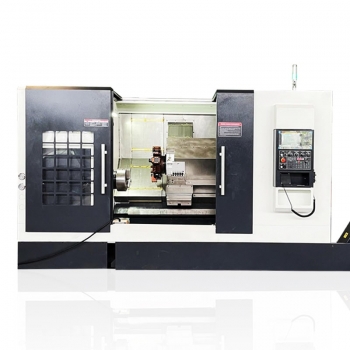High-Efficiency Machining Powerhouse!TCK700DY Achieves the Perfect Integration of Turning and Milling.
TCK700DY Turn-Mill CNC Machine Product Introduction The TCK700DY Turn-Mill CNC Ma.
What is a CNC Turning And Milling Machine?
A CNC Turning And Milling Machine is a high-precision CNC machine that integrates multiple machining processes, including turning, milling, drilling, tapping, and boring. It can complete multi-process machining of complex parts in a single setup, greatly improving machining efficiency and accuracy.
Main Application Industries
1. Automotive Industry: Machining engine blocks, transmission housings, brake discs, wheel hubs, and other components.
Multi-face machining in a single setup improves dimensional consistency and surface quality.
2. Aerospace Industry: Machining aircraft structural components, brackets, and engine parts.
High rigidity and multi-axis capability suitable for complex surfaces and thin-walled parts.
3. Mold Manufacturing Industry: Machining mold frames, cores, mold bases, and fixtures.
Achieves high precision and surface finish, suitable for hard materials.
4. Construction Machinery Industry: Machining hydraulic cylinders, pump housings, shafts, and connecting seats.
Supports large-size and high-strength material processing.
5. Energy Equipment Industry: Machining generator shafts, wind turbine shafts, pump shafts, and other high-precision components.
Ensures long-term stability and dimensional accuracy.
6. Hardware and General Mechanical Parts: Machining various small-to-medium shafts, discs, threaded parts, and connectors.
High efficiency meets small-to-medium batch automated production requirements.
Frequently Asked Questions (FAQ)
1. How does a CNC Turning And Milling Machine differ from a standard CNC lathe?
Standard CNC lathes can only perform turning; milling, drilling, or tapping requires a second setup.
CNC Turning And Milling Machines can complete turning, milling, drilling, and tapping in a single setup, improving efficiency and accuracy.
2. What materials can be machined?
Carbon steel, stainless steel, alloy steel, aluminum, copper, titanium alloys, cast iron, etc.
Suitable for light, medium, and heavy cutting applications.
3. Common axis configurations
Typically 3~5 axes (X, Z, C, optional Y-axis).
Equipped with turrets or powered tool magazines for rapid multi-process tool changes.
Optional spindle tapping, boring, and face milling.
4. How to select the right model?
Consider part dimensions (diameter and length).
Part type (shaft, disc, housing, mold).
Batch size (single piece, small batch, or mass production).
Automation needs (material handling, robotic arms, tool magazine).
5. Daily maintenance tips
Keep bed guideways, ball screws, and turret clean.
Regularly check lubrication, cooling system, and spindle condition.
Inspect tool wear and tool change accuracy.
Calibrate machine accuracy periodically to prevent thermal deformation.
6. Main advantages of a CNC Turning And Milling Machine
Multi-process machining in a single setup, reducing errors.
High-rigidity spindle and turret, suitable for heavy cutting.
Multi-axis linkage, capable of machining complex surfaces.
High automation, can integrate loading/unloading, robotic arms, tool magazines.
High precision and efficiency, ideal for batch production.
